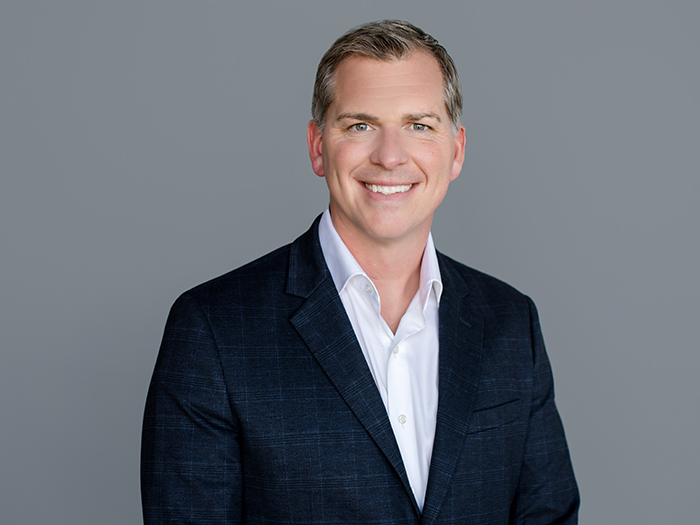Six Questions for Tim Fleming, CEO of The Mutual Group

This fall, Dan Reynolds, the editor-in-chief of Risk & Insurance, spoke with Tim Fleming, the Chief Executive Officer of The Mutual Group about the company’s origins and business opportunities. What follows is a transcript of that discussion, edited for length and clarity.
Risk & Insurance: Thanks for agreeing to meet with us Tim. What is the background of The Mutual Group and why was it formed?
Tim Fleming: The concept of The Mutual Group was formed a few years ago through a connection that Bain Capital Insurance made. They had started a new insurance investment fund and wanted to work with mutual insurers, a community underserved by traditional capital markets. Around the same time, Chuck Chamness, the long-time CEO of NAMIC, the mutual insurance industry trade group, had just retired. Bain brought him on as an advisor to figure out how to meaningfully work with this community and bring solutions to them.
After considering traditional models like surplus notes, they realized there was a need for something new and innovative that brought together both a capital solution and operational solutions. The idea was inspired by the attorney-in-fact reciprocal exchange relationship but applied in a mutual insurance company context. They had the concept, which was a great one, but needed a company to work with to get started. About a year ago, a connection was made with GuideOne Insurance, which had some needs that this could be a really good fit for.
From the initial introduction in August of last year to closing the transaction in December, it was an exciting time that launched The Mutual Group. Bain’s investment provided capital to GuideOne, giving them a $200 million surplus, while the people, technology, and operating components of GuideOne were purchased to form The Mutual Group. We now have a long-term service agreement with GuideOne where we provide comprehensive services to them.
GuideOne stayed independent, retained their brand, board and everything that made them successful for over 75 years. We can now take this same model and apply it to other mutual insurance companies with similar needs and opportunities. They would become additional members, with GuideOne as the first. Capital would go in, people and technology would join our shared services platform, and we would enter a long-term services agreement to work together.
R&I: What size and type of mutual insurance companies are you targeting for business opportunities?
TF: We believe our target market is quite broad within the mutual insurance community, particularly in the mid-sized segment. This could include regional companies or national niche players like GuideOne.
However, given the extensive nature of these transactions and the depth of the relationships required, a certain scale is necessary. We estimate the lower end of our target range to be around $100 million in premium, extending to about $1 billion, which is the size of GuideOne. This is the range where we believe our solution can be most powerful and where we can provide the greatest value. Our initial findings seem to validate this assumption.
R&I: What is the nature of your company’s solution? Does it primarily involve consultancy, or is there a capital component as well?
TF: Unlike vendors or consultants, The Mutual Group offers a long-term solution for capital and operational support by combining our resources with our member companies to enhance their competitiveness without compromising their mutual status. We have access to substantial resources, which allows us to provide scaled capital solutions.
For instance, our GuideOne commitment was $200 million, a level of funding that is quite uncommon in the industry. This involves acquiring operating assets in exchange for the capital provided, followed by an extended period of collaboration and support.
R&I: What is the balance between working with mutuals in distress versus those looking to grow and expand but lacking resources? Additionally, who are the key decision-makers within the mutual companies that ultimately agree to partner with The Mutual Group?
TF: Our solution is not exclusively for distressed companies, although it could be applicable in certain situations. More broadly, we find that most midsize mutual insurance companies face constraints that prevent them from achieving their ambitions and goals. For some, like GuideOne, the constraint was capital. They had many good pieces in place but lacked the capital to support their long-term vision of serving religious organizations and nonprofits. Our solution allowed them to access the necessary resources to deliver on that vision.
Other companies may be held back by limited access to technology and talent. A common scenario is a company looking to modernize its legacy systems but facing a significant price tag and the industry’s track record of failed technology implementations that have wiped out substantial portions of surplus. We describe this as the real, hard technology risk that exists in the industry.
We also work with companies that have all the pieces in place, a good model, and want to expand from three states to twelve, but lack the resources, expertise, or distribution relationships to do so. We can help facilitate their growth in a disciplined and productive manner that might have been difficult to achieve independently.
Once potential partners understand our model, we engage in exciting conversations about their constraints and aspirations. It’s rewarding to work with passionate individuals and help them remove obstacles to achieve their goals. We often find that the constraints they face are very solvable through our partnership.
R&I: What are the main challenges in getting people to understand and adopt this new business model?
TF: One of the primary challenges is simply getting people to understand the concept, as it’s something that has never existed before. It takes time for people to wrap their heads around this novel idea.
We’re having conversations with CEOs and boards of directors who are deeply passionate and committed to the success of their organizations, members, brand, and the experience they provide to their employees and the communities they serve. This is very personal to them.
The idea of taking a risk and engaging in a partnership of this scale represents a significant change in their business model, and it’s a decision they take very seriously, as they should. Having been on the side of a company that made this decision, we certainly didn’t take it lightly, and they shouldn’t either.
However, once they work through the initial apprehension and recognize the potential opportunity on the other side for their company, policyholders, and employees, we’ve seen some very positive responses.
R&I: What excites you about the opportunity in front of The Mutual Group?
TF: There are several aspects that excite me about the opportunity ahead for The Mutual Group. First, seeing GuideOne, a company I deeply care about, succeed, and thrive under this new structure is incredibly gratifying. They’re having a great year, and the model is working very well for them, setting them up for continued success in the future.
Second, as we’ve been sharing our message with other mutuals and outlets, the response has been overwhelmingly positive. In these challenging times, with real constraints and risks, companies recognize the value we can bring in helping them envision a future with a higher probability of success under a different model.
We’re just getting started on growing from a single-member organization with GuideOne to a multiple-member organization. As we bring on additional members, it will enhance our capabilities and allow us to broaden the service we provide. We fully expect to have several members as we continue to grow and expand, and we believe this model works.
Lastly, I’m excited for the people. This high-growth organization is different, unique, innovative, and attracts great talent. People who were with GuideOne, like myself, now have the opportunity to broaden their roles, grow their careers, and achieve success beyond what they thought possible under the prior structure. It’s incredibly rewarding to witness this growth and development. &










